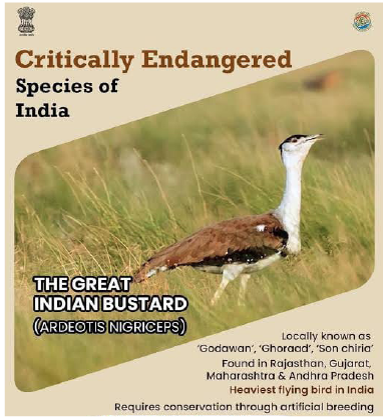
Project Great Indian Bustard (Project GIB) remains at the forefront of efforts to conserve one of India’s most iconic birds. Ever since its launch, the Great Indian Bustard Project has contributed immensely towards saving the endangered Bustard. This article aims to study in detail the Project Great Indian Bustard (Project GIB), its objectives, measures taken, achievements, significance and other related aspects.
About Project Great Indian Bustard (Project GIB)
- Project Great Indian Bustard (Project GIB) is a conservation project launched by the Government of Rajasthan, aimed at reviving the population of the critically endangered Indian Bustard (Ardeotis nigriceps).
- It was launched in 2013.
Although Indian Bustard was brought under the umbrella of the Wildlife (Protection) Act, 1972, it did not gain attention and remained BPL (Below Protection Line); The Bustard Project can be seen as the dawn of a new era for the conservation of neglected species.
Objectives of Project Great Indian Bustard
The objective of the Bustard Project is to conserve the remaining population of critically endangered Bustard.
What is Great Indian Bustard (Ardeotis nigriceps)?
- The Great Indian Bustard is a large, ground-dwelling bird, often described as one of the heaviest flying birds in the world.
- Its height is up to one meter.
- It is distinguished by its black crown on the forehead, which contrasts with its pale neck and body.
- It is a grassland species and is considered as indicator of the health of our grasslands or the pulse of the grassland ecosystem.
- It is the state bird of Rajasthan.
- It is locally called Godawan.
- IUCN Status: critically endangered

Threats to Great Indian Bustard
- Once more than 1000 individuals a few decades back, the bustard population shrunk to 745 in the year 1978, 600 in 2001, 300 in 2008 and not more than 125 in the year 2013.
- The rapid decline in its population across its distribution has already alarmed wildlife experts, ornithologists and bird lovers across the world.
- The main reasons cited for its decline include:
- Habitat loss due to conversion of grasslands to other purposes,
- Anthropogenic and related biotic disturbances during its breeding season, and
- Frequent poaching of the species as game birds.
Measures Taken under Project Great Indian Bustard
The Project Great Indian Bustard involves a combination of in-situ (on-site) and ex-situ (off-site) conservation strategies as described below:
In-situ Conservation Measures
- Protected Areas: Establishing and expanding protected areas where the birds are known to breed.
- The Desert National Park in Rajasthan is one of the key habitats under protection.
- Habitat Restoration: Efforts are being made to restore degraded grasslands and create conducive environments for the bustard’s survival.
- The Ministry of Environment, Forest and Climate Change has come up with “firefly bird diverter” for overhead power lines. They will work as reflectors for Indian bustard to avoid collision with power lines.
- Community Involvement: Engaging local communities in conservation efforts, including reducing disturbances in breeding areas and promoting sustainable land use practices.
Ex-situ Conservation Measures
- Captive Breeding: A dedicated captive breeding program has been initiated to breed bustards in controlled environments, with the aim of reintroducing them into the wild.
- Research and Monitoring: Continuous research is conducted to understand the bird’s ecology and identify threats.
- Satellite telemetry is used to track the movements of the birds to ensure their safety.
Achievements of Project Great Indian Bustard
- Project Great Indian Bustard has made significant strides in raising awareness and taking actionable steps to protect the species.
- The breeding success in captivity and the expansion of protected areas are positive signs.
Challenges in Conservation of GIB
While Project Great Indian Bustard has made significant strides, several challenges persist in the conservation of the Indian Bustard:
- Land Use Change: The increasing pressure on grasslands for agriculture and development remains a major threat to the species.
- Lack of Awareness: Public awareness about the GIB and its conservation needs is very poor.
- Financial Constraints: Adequate funding is essential for the long-term success of the Bustard Project.
Suggested Measures to Protect GIB
The following measures can be taken to protect the Indian Bustard:
- Intensive Patrolling by the field staff.
- Developing an intelligence network in the area.
- Making of check posts and barriers at strategic locations.
- Creation of a flying squad headed by not below the rank of a range officer.
- Strengthening of existing Wireless Network.
- Habitat protection through creation of some inviolate areas for the bird by making some closures of appropriate size and restricting anthropogenic pressures.
- Habitat enrichment through planting grasses like Lasiurus sindicus (sewan grass) and providing water facilities like water gazellers.
- Incentives to farmers and local people for giving information and protection of the species.
- Involving local people in the eco-development and eco-tourism activities.
- Generating mass awareness and sensitisation among the masses.
- Continuous monitoring of the species and habitat.
Conclusion
Project Great Indian Bustard (Project GIB) is a testament to the country’s commitment to conserving its natural heritage. Though this project has contributed significantly to the conservation of the Bustard, much more needs to be done. The success of the Project Great Indian Bustard depends on continued efforts, both at the governmental and community levels, to ensure that this magnificent species does not become extinct.
Frequently Asked Question (FAQ)
Where is the Great Indian Bustard found in India?
In India, they are found mainly in the states of Rajasthan and Gujarat, though some populations are also in the states of Maharashtra, Karnataka, and Andhra Pradesh.






